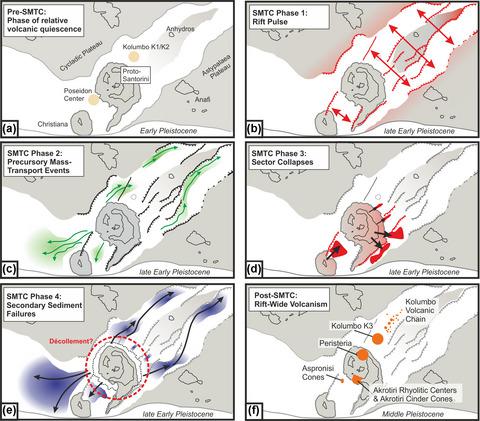当前位置:
X-MOL 学术
›
Basin Res.
›
论文详情
Our official English website, www.x-mol.net, welcomes your
feedback! (Note: you will need to create a separate account there.)
The Hidden Giant: How a rift pulse triggered a cascade of sector collapses and voluminous secondary mass-transport events in the early evolution of Santorini
Basin Research ( IF 2.8 ) Pub Date : 2022-04-06 , DOI: 10.1111/bre.12667 J. Preine 1 , J. Karstens 2 , C. Hübscher 1 , G. J. Crutchley 2 , T.H. Druitt 3 , F. Schmid 2 , P. Nomikou 4
Basin Research ( IF 2.8 ) Pub Date : 2022-04-06 , DOI: 10.1111/bre.12667 J. Preine 1 , J. Karstens 2 , C. Hübscher 1 , G. J. Crutchley 2 , T.H. Druitt 3 , F. Schmid 2 , P. Nomikou 4
Affiliation

|
Volcanic island sector collapses have the potential to trigger devastating tsunamis and volcanic eruptions that threaten coastal communities and infrastructure. Considered one of the most hazardous volcano-tectonic regions in the world, the Christiana-Santorini-Kolumbo Volcanic Field (CSKVF) lies in the South Aegean Sea in an active rift zone. Previous studies identified an enigmatic voluminous mass-transport deposit west and east of Santorini emplaced during the early evolution of the edifice. However, the distribution and volume as well as the nature and emplacement dynamics of this deposit remained unknown up to now. In this study, we use an extensive dataset of high-resolution seismic profiles to unravel the distribution and internal architecture of this deposit. We show that it is located in all basins surrounding Santorini and has a bulk volume of up to 125 km3, thus representing the largest known volcanic island mass-transport deposit in the entire Mediterranean Sea. We propose that the deposit is the result of a complex geohazard cascade that was initiated by an intensive rift pulse. This rifting event triggered a series of smaller precursory mass-transport events before large-scale sector collapses occurred on the northeastern flank of the extinct Christiana Volcano and on the southeastern flank of the nascent Santorini. This was followed by the emplacement of large-scale secondary sediment failures on the slopes of Santorini, which transitioned into debris and turbidity flows that traveled far into the neighboring rift basins. Following this cascade, a distinct change in the volcanic behaviour of the CSKVF occurred, suggesting a close relationship between crustal extension, mass transport and volcanism. Cascading geohazards seem to be more common in the evolution of marine volcanic systems than previously appreciated. Wider awareness and a better understanding of cascading effects are crucial for more holistic hazard assessments.
中文翻译:

隐藏的巨人:裂谷脉冲如何在圣托里尼岛的早期演化中引发一连串的扇区崩溃和大量的二次质量传输事件
火山岛部分的坍塌有可能引发毁灭性的海啸和火山爆发,威胁沿海社区和基础设施。克里斯蒂安娜-圣托里尼-科伦坡火山区 (CSKVF) 被认为是世界上最危险的火山构造区之一,位于南爱琴海的一个活跃裂谷带中。以前的研究确定了在圣托里尼岛西部和东部的一个神秘的大量质量运输沉积物,该沉积物是在这座大厦的早期演化过程中安置的。然而,到目前为止,该矿床的分布和体积以及性质和就位动态仍然未知。在这项研究中,我们使用高分辨率地震剖面的广泛数据集来揭示该矿床的分布和内部结构。3,因此代表了整个地中海中已知的最大的火山岛大规模运输矿床。我们认为该矿床是由强烈的裂谷脉冲引发的复杂地质灾害级联的结果。在已灭绝的克里斯蒂安娜火山的东北侧和新生的圣托里尼岛的东南侧发生大规模扇形坍塌之前,这一裂谷事件引发了一系列较小的前体大规模运输事件。随后在圣托里尼岛的斜坡上出现了大规模的次生沉积物破坏,这些破坏转变为碎屑和浊流,并深入邻近的裂谷盆地。在这一级联之后,CSKVF 的火山行为发生了明显变化,表明地壳伸展、大众运输和火山活动。在海洋火山系统的演化过程中,级联地质灾害似乎比以前认为的更为常见。更广泛的认识和对级联效应的更好理解对于更全面的危害评估至关重要。
更新日期:2022-04-06
中文翻译:

隐藏的巨人:裂谷脉冲如何在圣托里尼岛的早期演化中引发一连串的扇区崩溃和大量的二次质量传输事件
火山岛部分的坍塌有可能引发毁灭性的海啸和火山爆发,威胁沿海社区和基础设施。克里斯蒂安娜-圣托里尼-科伦坡火山区 (CSKVF) 被认为是世界上最危险的火山构造区之一,位于南爱琴海的一个活跃裂谷带中。以前的研究确定了在圣托里尼岛西部和东部的一个神秘的大量质量运输沉积物,该沉积物是在这座大厦的早期演化过程中安置的。然而,到目前为止,该矿床的分布和体积以及性质和就位动态仍然未知。在这项研究中,我们使用高分辨率地震剖面的广泛数据集来揭示该矿床的分布和内部结构。3,因此代表了整个地中海中已知的最大的火山岛大规模运输矿床。我们认为该矿床是由强烈的裂谷脉冲引发的复杂地质灾害级联的结果。在已灭绝的克里斯蒂安娜火山的东北侧和新生的圣托里尼岛的东南侧发生大规模扇形坍塌之前,这一裂谷事件引发了一系列较小的前体大规模运输事件。随后在圣托里尼岛的斜坡上出现了大规模的次生沉积物破坏,这些破坏转变为碎屑和浊流,并深入邻近的裂谷盆地。在这一级联之后,CSKVF 的火山行为发生了明显变化,表明地壳伸展、大众运输和火山活动。在海洋火山系统的演化过程中,级联地质灾害似乎比以前认为的更为常见。更广泛的认识和对级联效应的更好理解对于更全面的危害评估至关重要。











































 京公网安备 11010802027423号
京公网安备 11010802027423号